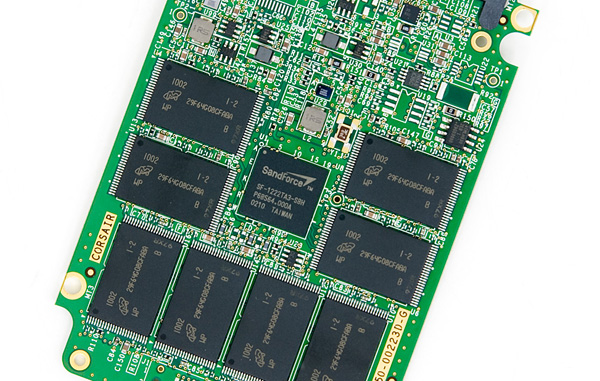This Just In: Corsair Force 100GB SSD (SF-1200)
by Anand Lal Shimpi on April 13, 2010 9:43 AM ESTTesting is nearly complete on the last Corsair SSD that came my way, but this morning UPS dropped off another surprise: the Corsair Force SSD. Based on a derivative of the controller in the OCZ Vertex LE I reviewed earlier this year, the Force uses the mainstream version of SandForce's technology. Here's how it breaks down. Last year's Vertex 2 Pro used a SF-1500 controller, the Vertex LE uses something in between a SF-1500 and SF-1200 (closer to the SF-1500 in performance) while the Corsair Force uses a SF-1200.
The SF-1200 has all of the goodness of the SF-1500, just without some of the more enterprise-y features. I haven't been able to get a straight answer from anyone as to exactly what you give up by going to the SF-1200 but you do gain a much more affordable price. The Vertex LE is only low in price because it is using a limited run of early controllers from SF, presumably so SandForce can raise capital. The SF-1200 based SSDs should be price competitive with current Indilinx offerings.

You'll notice that like the Vertex LE there's no supercap on the Force's PCB. There's also no external DRAM cache thanks to a large amount of on-die cache and SandForce's real time data compression/deduplication technology. As you may remember from my Vertex 2 Pro and Vertex LE reviews, SandForce achieves higher performance by simply reducing the amount of data it has to write to NAND (similar to lossless compression or data deduplication).
I've got the Force on my SSD testbench now and I should have the first results by the end of the day today. This one is exciting as it could give us a preview of what the performance mainstream SSD marketplace will look like for the rest of 2010.
More pics of the drive in the Gallery!










41 Comments
View All Comments
semo - Tuesday, April 13, 2010 - link
I think for this drive you nee to do a test with completely random data which will give you an idea of the drive's real speed without SF sauce. If this thing is as quick with random data as indilinx drives then it'll be impressive.vol7ron - Tuesday, April 13, 2010 - link
How does this differ from the other random tests that Anand performs? Anand's test comes pretty close to "general" real world situations.rmlarsen - Tuesday, April 13, 2010 - link
You don't undertand. The point of using random DATA is that they don't compress. It would be interesting to find out if the SF controller can maintain its high performance once deprived of the ability to compress the data. The "random" in Anand's usual tests are in the pattern of access, not the contents of the data.vol7ron - Tuesday, April 13, 2010 - link
I guess I'm still missing what you're saying about the random data. I thought Anand's test are both about random access, and random data (hence read and write) with different programs.If you're talking about data generation, then wouldn't that put work on the CPU, not the storage - compressed or not.
CommandoCATS - Tuesday, April 13, 2010 - link
I think the OP meant randomly generated (e.g. noise) data. This data is in general impossible to compress in a lossless manner due to being at the entropy limit http://en.wikipedia.org/wiki/Entropy_%28informatio... I think the OP was just saying that this will allow a test which bypasses any lossless compression tricks and see what the underlying hardware is capable of.semo - Wednesday, April 14, 2010 - link
you've described in a much better way than i could. And yes this is exactly what i meant.I'll go and bitch and moan about this in the review since the editors are probably not even reading these comments anymore
Rob94hawk - Tuesday, April 13, 2010 - link
I'm holding out waiting patiently for improvements with SSD's. Even if I have to wait another year. I just don't think the maturity or reliability is there just yet. Maybe by the time the X68 chipset arrives.Slaimus - Tuesday, April 13, 2010 - link
Assuming those 8 flash chips add up to 128GB, along with the compression, there must be a lot of reserved blocks. That is probably the key to SF controller's high performance.semo - Tuesday, April 13, 2010 - link
yeah i read somewhere that they have an unusually large reserve.btw, anyone know of anyone releasing a ram drive... those acard models seem too expensive to me.
JarredWalton - Tuesday, April 13, 2010 - link
Looking at the images, those memory chips are 8GB each (Micron 29F64G08CFABA) and there are 16 of them (eight on each side of the PCB). That makes for 128GB total with 28GB of spare area. And of course, if Corsair is like most companies, that's 128GiB (Gibibytes) with an accessible capacity of 100GB (Gigabytes), which means formatted capacity is actually 93GiB (Gibibytes). So they're using 37% of the total capacity as spare area.